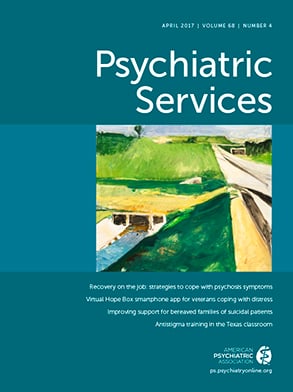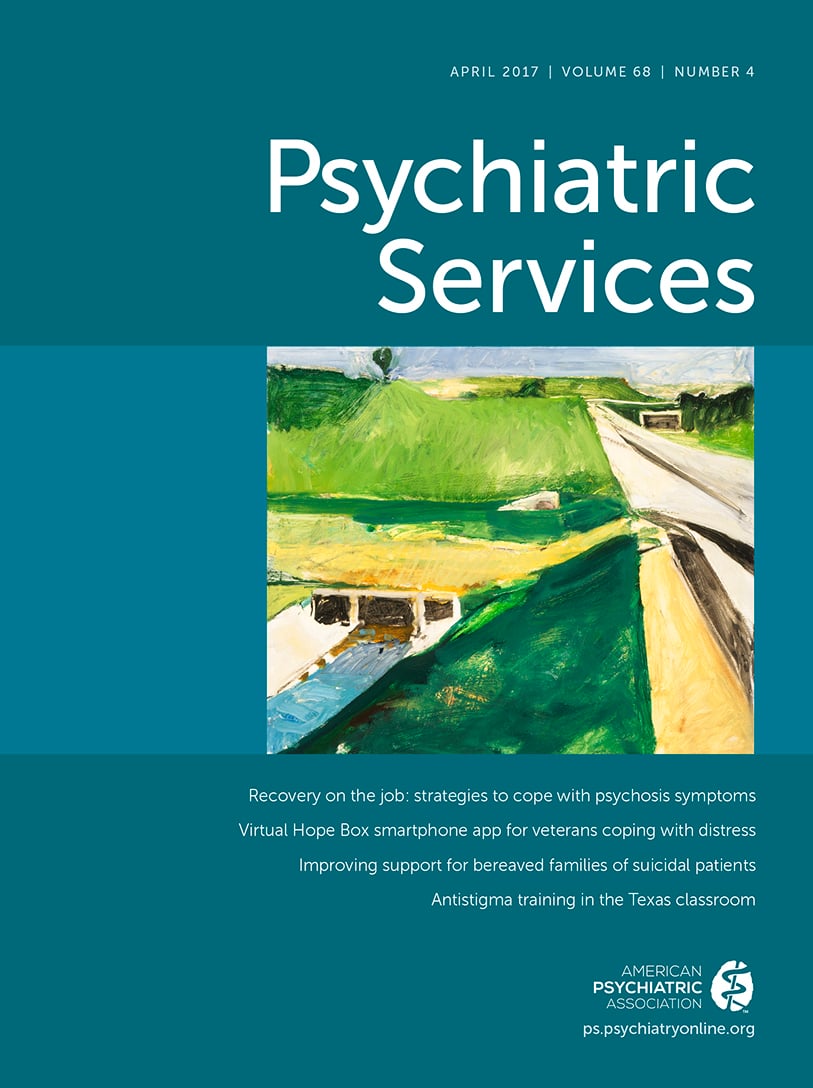Despite the prevalence of and impairment associated with mental disorders in adolescence and despite the existence of effective treatments for mental disorders, the vast majority of adolescents who need mental health services do not receive any services (
1,
2). Many barriers to mental health care exist, such as stigma, finite resources, policy constraints, disjointed services, and unequal access (
3–
5). For youths, parent burden plays a significant role in lack of treatment. In addition to experiencing long wait times (
6,
7), parents can face financial and logistical barriers to securing even initial psychiatry appointments for adolescents. Notably, a recent study of wait times for appointments with adolescent psychiatrists at clinics in New York State revealed that only two-thirds of callers could schedule a psychiatry appointment. The median wait time for callers who successfully scheduled an appointment was six weeks for a psychiatrist appointment and three weeks for a therapy appointment (
8). Besides long wait times, the parents of adolescents may encounter specific obstacles while trying to access psychiatric care for children, and there is little documentation of these barriers.
This study utilized mystery shopper methodology to understand the barriers faced by parents of adolescents when seeking outpatient psychiatric care for their adolescents’ depression in a large state system. Furthermore, we examined whether barriers to access differ by geographic region, urbanicity, clinic type, seasonality, and insurance. We hypothesized that parent burden would be higher in nonmetropolitan versus metropolitan clinics, in summer versus spring (when clinician vacation time may tax available clinical hours), and among those with Medicaid versus commercial insurance.
Methods
The study population is all New York State Office of Mental Health (NYS OMH) outpatient mental health clinics that are licensed to serve children and adolescents and that had been in operation since October 2012 (N=340); 265 (78%) were community-based clinics, 58 (17%) were outpatient hospital facilities, and 17 (5%) were state-run facilities. Given the relatively small number of outpatient hospital facilities and state-run facilities, all of these clinics were included in the study sample. Data were collected in the spring and summer of 2014. As the outpatient hospital and state-run facilities represent 17% and 5% of the eligible population, respectively, all of these clinics were sampled with certainty (N=75). Approximately 70% (N=191) of the 264 community clinics remaining after random assignment were selected via stratified random sampling by region (New York City, Long Island, Hudson, Central, and Western) and urbanicity (metropolitan versus nonmetropolitan county). All selected clinics were randomly assigned to the season in which they were contacted (spring versus summer) and insurance condition (Medicaid versus commercial). This study was a quality improvement project approved by the NYS OMH and, hence, was exempt from review by the institutional review board.
The study utilized a mystery shopper study design (
8). Using a standardized script, four trained callers contacted clinics posing as English-speaking mothers seeking psychiatry appointments for their 14-year-old daughters after a recent relocation. The “mother” explained to clinic staff that her adolescent was previously prescribed antidepressant medication but her symptoms were worsening and the child needed a psychiatrist appointment for a potential medication adjustment. In addition to requesting a psychiatry appointment, the “mother” also discussed scheduling a therapy appointment and inquired about whether cognitive-behavioral therapy (CBT) was available.
Callers made five separate call attempts to the same clinic to schedule an appointment if there was some initial contact with the clinic (for example, the caller spoke to a receptionist but was waiting to hear back from intake personnel). Callers left detailed voice-mail messages that included their name, phone number, and primary reason for calling, and they waited 48 hours before making a subsequent call attempt if the clinic did not return their call. If the caller was unable to speak with anyone at the clinic, three separate call attempts were made.
Because the study’s goal was to simulate a real-world referral, callers were provided with only the name and address of the clinics. The precall experience included the total amount of time required to find accurate clinic contact information, the number of call attempts, minutes on the phone, and number of people to whom the caller spoke.
All steps required before the psychiatry visit were systematically recorded, including preintake steps (insurance preauthorization; phone screen or intake; completion of paperwork by the parent, school, or primary care physician [PCP]; visit or referral to another PCP or physician; or other preintake appointment), minimum and maximum number of intake appointments prior to a psychiatry visit, and required therapy appointments prior to a psychiatry visit.
The analyses focused on three measures of parent burden: number of call attempts; minimum number of in-person appointments required prior to seeing a psychiatrist; and minimum number of steps required prior to seeing a psychiatrist. Sample weights were created to account for the unequal probability of selection of clinics. Unweighted counts and weighted percentages were used to summarize categorical variables. Weighted Poisson mixed-effects regression models with a random effect for agency (to account for the within-agency correlation; 21% of agencies had multiple clinics) were fitted to examine whether measures of parent burden varied by region, urbanicity, clinic type, season, and insurance. The data were analyzed by using SAS, version 9.3 (
9), and Stata/SE, version 14.0 (
10).
Results
The analytic sample consisted of 264 clinics (57 hospitals, 17 state-run facilities, and 190 community clinics). About half (N=116, 43%) of the clinics were located in New York City, and 86% (N=230) were in metropolitan areas. Most callers spent two or more minutes finding the correct contact information and made at least two call attempts. Callers were able to discuss scheduling a psychiatry appointment at 94% (N=248) of the clinics. About one-third of callers (N=93, 36%) spoke with at least three people (
Table 1). The number of call attempts did not vary by region, urbanicity, clinic type, season, or insurance (results not shown).
At the 248 clinics where callers were able to discuss scheduling a psychiatry appointment, 156 (63%) callers were able to schedule an intake or screening appointment in preparation for a psychiatry appointment. A total of 164 (67%) callers were able to schedule a therapy appointment (CBT was reported as available in 120 [74%] of these clinics). Callers were unable to schedule any appointments at 79 (31%) clinics because the clinic was at capacity (N=34); the adolescent did not meet the clinic’s criteria, for example, the adolescent was too young (N=31); insurance coverage was a barrier, for example, the facility did not accept Blue Cross Blue Shield plans or self-pay (N=9) or Medicaid (N=1) or required verification of insurance coverage (N=2); or a referral was needed from an emergency department or primary care physician (N=2). Nineteen percent (N=15) of callers who could not schedule an appointment were unable to obtain a referral to another clinic.
Of the 146 clinics that provided the caller with an actual or estimated date for a psychiatry appointment, 145 (99%) required at least one in-person appointment (for example, an intake appointment or a therapy session) prior to the psychiatry appointment, 39 (28%) required a minimum of two appointments, and 31 (21%) required a minimum of three to five appointments (
Table 1). Forty-two percent (N=59) of clinics required at least one therapy appointment prior to the psychiatry appointment, and 15% (N=21) of clinics required multiple therapy appointments.
The majority of parents or adolescents had to complete more than one step prior to the psychiatry appointment: 62 (43%) clinics required only one step, for example, an intake appointment; 38 (26%) required two steps, for example, paperwork and an intake appointment; and 46 (31%) required three or more steps, for example, paperwork, an intake appointment, and a referral. There were no significant differences in the minimum number of in-person appointments or steps required before a psychiatrist visit by region, urbanicity, clinic type, season, or insurance (results not shown).
Discussion
Most youths needing mental health services do not receive care. Existing research points to disparities in availability of services on the basis of geography, insurance status, and family income. Using a mystery shopper methodology, this study examined barriers faced by parents of adolescents seeking outpatient psychiatric care for their adolescents’ depression in a large state system.
In the current study, 156 of 248 callers (63%) were able to schedule an intake for a psychiatry appointment, and 19% of callers who could not make an appointment (15 of 79 callers) were not provided a referral. Parents were often subjected to several levels of hurdles before being able to consult with a psychiatrist. These hurdles included multiple attempts to reach someone at the clinic (at least two call attempts before reaching someone and speaking with at least two people before initiating scheduling); administrative paperwork, such as insurance documentation; and requirements for recommendations from other informants, such as schools. If scheduling was possible, virtually all clinics required one in-person intake or therapy appointment before a psychiatry appointment. This level of burden was quite typical across the state, and the level of parental burden did not differ by geographic region, urbanicity, clinic type, seasonality, or insurance. These null findings may be explained by the fact that these state-licensed clinics likely operate under similar regulations for care provision. For example, the state has invested in workforce training in evidence-based care. In accordance with current evidence-based guidelines of care for youths (
http://www.aacap.org/AACAP/Resources_for_Primary_Care/Practice_Parameters_and_Resource_Centers/Practice_Parameters.aspx), clinics often require an initial trial of a psychosocial intervention before allowing a psychiatrist appointment, even for adolescents who are already on medication. However, requiring an adolescent who is already taking medication to undergo the same procedures as a treatment-naïve adolescent may lead to less effective avenues of care. For example, a parent may instead seek care for a child from the child’s primary care doctor or even from the local emergency department to secure a child’s prescription. A more efficient strategy may be to tailor intake procedures to youths’ needs; bypassing burdensome procedures for psychiatry appointments in cases of medication adjustment may alleviate some of the clinic service burden.
Our findings focus only on parent burden in situations in which psychiatric care could be accessed; for a sizable proportion of calls (about 37%), a psychiatry appointment could not be made, even when callers were able to discuss scheduling an appointment. Our callers were trained English-speaking research assistants, who may be savvier than a layperson in accessing services and who did not have language barriers that may pose additional hurdles for some parents. Consequently, their experience may have produced practice effects that resulted in quicker and more effective ways to contact to clinics. Moreover, in a real-life situation, parents may not be as persistent after receiving no response from a clinic. Therefore, the data likely underestimate the actual burden and difficulty in scheduling an appointment faced by real families. Moreover, this study focused specifically on experiences seeking services for adolescent depression, which may not reflect parents’ experiences seeking services for other types of mental disorders.
Conclusions
Our findings across the state were sobering, especially in conjunction with epidemiologic data. Kessler and colleagues (
11) found that half of adults who have mental disorders show signs of illness by age 14; yet, on average, individuals experience a median delay of ten years between disease onset and first treatment contact (
12). Families of youths with unmet need often face considerable burden in providing care and accessing needed treatments, usually at high personal financial, emotional, and social costs. Strategies to improve and facilitate timely access to treatments are urgently needed; for youths with psychiatric disorders, the role of the family and, hence, parent burden are key.

